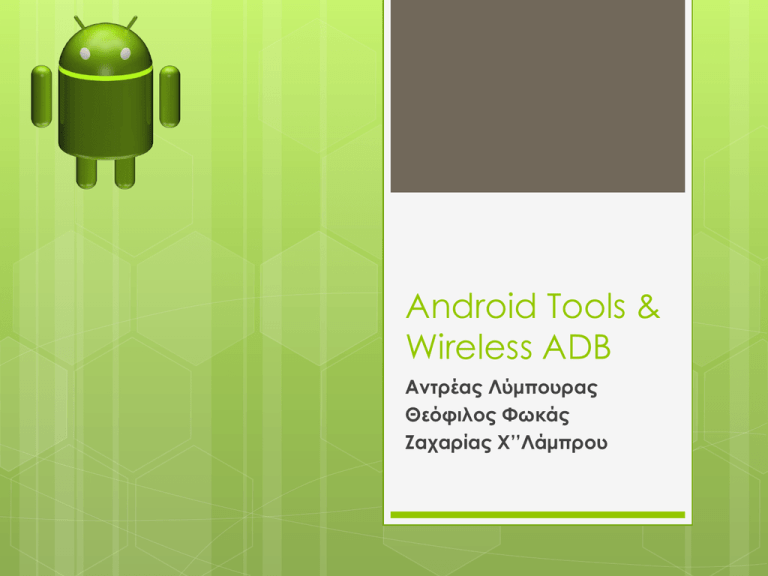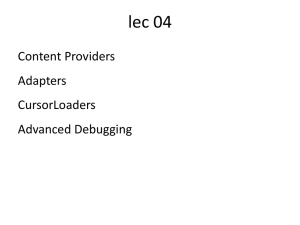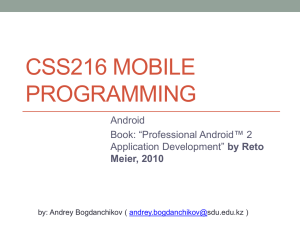Android Tools & Wireless ADB: Presentation
advertisement

Android Tools & Wireless ADB Αντρέας Λύμπουρας Θεόφιλος Φωκάς Ζαχαρίας Χ’’Λάμπρου Android Development Tools plugin (ADT) What is ADT? Plugin for Eclipse IDE designed to give you a powerful, integrated environment in order to build Android applications. What it Does? extends the capabilities of Eclipse to let you quickly set up new Android projects create an application UI add packages based on the Android Framework API debug your applications using the Android SDK tools export signed (or unsigned) .apk files in order to distribute your application A good way to start programming android devices is to use eclipse adt Very Easy to install DDMS Debugging tool called the Dalvik Debug Monitor Server (DDMS) Run From Eclipse: Click Window > Open Perspective > Other... > DDMS DDMS features Screen capture Thread and heap information Tracking memory allocation of objects Logcat System info Call and location data spoofing DDMS features DDMS features Thread information DDMS features Click Cause GC to start garbage collection and update the information DDMS features DDMS features Mechanism for collecting and viewing system debug output Logcat dumps a log of system messages, stack traces when error occurs and user messages written with the Log class You can filter the log for viewing only messages from a particular process, error messages, debug messages warning messages etc DDMS features Android monkey runners The Monkey is a program that runs on your emulator or device and generates random events such as clicks, touches, or gestures, as well as a number of system-level events. You can use it for testing your application You can set a number of options like number of event to attempt, event types and frequencies, delay between the events How to run monkey? adb shell monkey -v -p your.package.name 300 Android Debug Bridge (ADB) What is ADB? command line tool that lets you communicate with an emulator instance or connected Android-powered device Contains three major components Client – on development machine Server – background process on development machine Daemon – on emulator or device Android Debug Bridge (ADB) What it does? Issue shell commands Push files to the device Pull files from device Install files remotely Android Debug Bridge (ADB) How to execute a command? adb -s <serialNumber> <command> Major ADB Commands adb devices - List of devices attached adb install <path_to_apk> Push command Android Debug Bridge (ADB) ..Major ADB Commands adb pull /sdcard/foo.txt foo.txt adb shell adb shell [<shellCommand>] Android Remote ADB Bridge ADB commands over Wi-Fi.. Purpose: Execute commands Transfer files Control your phone ADB Client (Android phone) setprop service.adb.tcp.port <port> Stop adb Start adb Remote Device adb tcpip <port> adb connect <IP Of your phone>:<port> Limitations Two • • major limitations Wired part of the procedure (unrooted devices) Doesn’t work for all unrooted phones Our Approach Remote Php web server MySQL database Client Device (Android device) Android application Post IP to server Background service for accepting requests Advantages Everything done wireless Easy switching between devices Simple interface for entering commands References.. http://developer.android.com/guide/index.html http://developer.android.com/guide/topics/manifest/uses-libraryelement.html http://developer.android.com/guide/developing/tools/adb.html http://developer.android.com/guide/developing/debugging/ddms.ht ml http://developer.android.com/sdk/eclipse-adt.html








